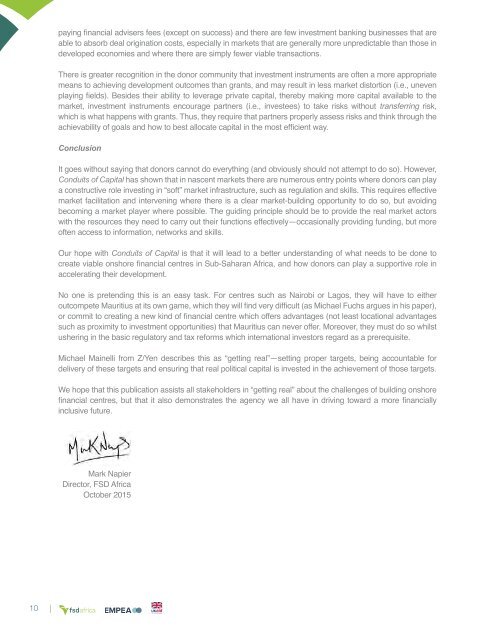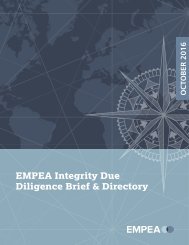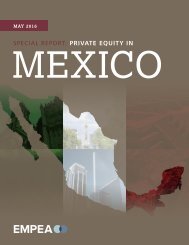Create successful ePaper yourself
Turn your PDF publications into a flip-book with our unique Google optimized e-Paper software.
paying financial advisers fees (except on success) and there are few investment banking businesses that are<br />
able to absorb deal origination costs, especially in markets that are generally more unpredictable than those in<br />
developed economies and where there are simply fewer viable transactions.<br />
There is greater recognition in the donor community that investment instruments are <strong>of</strong>ten a more appropriate<br />
means to achieving development outcomes than grants, and may result in less market distortion (i.e., uneven<br />
playing fields). Besides their ability to leverage private capital, thereby making more capital available to the<br />
market, investment instruments encourage partners (i.e., investees) to take risks without transferring risk,<br />
which is what happens with grants. Thus, they require that partners properly assess risks and think through the<br />
achievability <strong>of</strong> goals and how to best allocate capital in the most efficient way.<br />
Conclusion<br />
It goes without saying that donors cannot do everything (and obviously should not attempt to do so). However,<br />
<strong>Conduits</strong> <strong>of</strong> <strong>Capital</strong> has shown that in nascent markets there are numerous entry points where donors can play<br />
a constructive role investing in “s<strong>of</strong>t” market infrastructure, such as regulation and skills. This requires effective<br />
market facilitation and intervening where there is a clear market-building opportunity to do so, but avoiding<br />
becoming a market player where possible. The guiding principle should be to provide the real market actors<br />
with the resources they need to carry out their functions effectively—occasionally providing funding, but more<br />
<strong>of</strong>ten access to information, networks and skills.<br />
Our hope with <strong>Conduits</strong> <strong>of</strong> <strong>Capital</strong> is that it will lead to a better understanding <strong>of</strong> what needs to be done to<br />
create viable onshore financial centres in Sub-Saharan Africa, and how donors can play a supportive role in<br />
accelerating their development.<br />
No one is pretending this is an easy task. For centres such as Nairobi or Lagos, they will have to either<br />
outcompete Mauritius at its own game, which they will find very difficult (as Michael Fuchs argues in his paper),<br />
or commit to creating a new kind <strong>of</strong> financial centre which <strong>of</strong>fers advantages (not least locational advantages<br />
such as proximity to investment opportunities) that Mauritius can never <strong>of</strong>fer. Moreover, they must do so whilst<br />
ushering in the basic regulatory and tax reforms which international investors regard as a prerequisite.<br />
Michael Mainelli from Z/Yen describes this as “getting real”—setting proper targets, being accountable for<br />
delivery <strong>of</strong> these targets and ensuring that real political capital is invested in the achievement <strong>of</strong> those targets.<br />
We hope that this publication assists all stakeholders in “getting real” about the challenges <strong>of</strong> building onshore<br />
financial centres, but that it also demonstrates the agency we all have in driving toward a more financially<br />
inclusive future.<br />
Mark Napier<br />
Director, FSD Africa<br />
October 2015<br />
10 |





